Somapalem, Chennakeshava Temple
Historical background
This temple, dedicated to a form of Vishnu, the ‘Handsome Keshava’, is located in a remote area of Madanapalle district, Andhra Pradesh.
Read more
It was probably built during the Vijayanagara period, towards the middle of the 16th century by a local governor. This is one of the very few temples, besides Lepakshi, where Vijayanagara period murals have survived.
In his note on the Somapalem temple, J.H. Cousins wrote in 1937: “It is on the verandah in front of the door to the shrine (where ‘puja’ is performed once a week) that the eye is caught by patches of colour on the ceiling, once a series of paintings on plaster over granite ceiling- slabs. The paintings are in a lamentable state of decay. But the fragments of fine colouring, the character shown in groups and the individuals either in repose or vigorous action, the costuming, the glimpse of structures and equipages, all cry out for protection against individuals who scrawl their names over these paintings. They appear to be based on incidents from the Ramayana…. A study of them will add important data on the history of mural art in South India”. (“Note on the Vishnuite Temple at Somapalem” in Journal of the Indian Society of Oriental Art, Calcutta, Vol. V, 1937, pp. 131-45). Unfortunately, the situation has further deteriorated as could be ascertained during repeated visits between the 1990s and 2016.
Stylistically the paintings are related to those at Lepakshi, there are however differences, such as: the projecting further eye is a consistent feature, details of costumes and headgears. From the faded vestiges it is possible to detect the rich variety of the textile patterns.
Although probably the complete Ramayana once graced the ceiling of the open mandapa, only a few episodes can be identified with certitude. Among these are: Rama slaying Tataka, a remarkable fragment for its sheer vitality and tremendous expressive force; Janaka’s servants carrying Shiva’s bow; the four royal weddings are, unfortunately, reduced to a mere shadow; Dasharatha trying to mollify Kaikeyi, and Rama and Lakshmana taking leave of Dasharatha. Not much is left of the other parts of the narrative, except fragments of the Yuddhakanda.
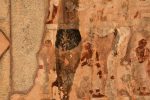
Date: 16th century
Description: In the course of their wanderings in the forest, Vishvamitra and his charges arrive at the bank of a river.
Location: Andhra Pradesh Temple;Chennakeshava Temple;Somapalem
Positioning: Open mandapa, ceiling
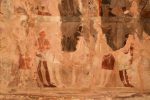
Date: 16th century
Description: Rama, Sita and Lakshmana converse with Guha (?) and his retainer.
Location: Andhra Pradesh Temple;Chennakeshava Temple;Somapalem
Positioning: Open mandapa, ceiling
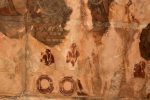
Date: 16th century
Description: Unidentified scene: The exiles on a chariot are addressed by a rishi (?).
Location: Andhra Pradesh Temple;Chennakeshava Temple;Somapalem
Positioning: Open mandapa, ceiling
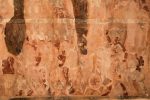
Date: 16th century
Description: Group of standard bearers and horsemen.
Location: Andhra Pradesh Temple;Chennakeshava Temple;Somapalem
Positioning: Open mandapa, ceiling
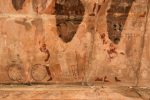
Date: 16th century
Description: Rama, Sita and Lakshmana take leave of the queens before going into exile.
Location: Andhra Pradesh temple;Chennakeshava Temple;Somapalem
Positioning: Open mandapa, ceiling
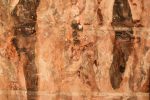
Date: 16th century
Description: (From left): Rama receives the magic weapons from Vishvamitra; Vishvamitra, seated on a throne, and the princes at the court of Janaka.
Location: Andhra Pradesh Temple;Chennakeshava Temple;Somapalem
Positioning: Open mandapa, ceiling

Date: 16th century
Description: Top row: The arrival of Rishyashringa in Ayodhya: Bottom row: Rama receives the magic weapons
from Vishvamitra; Vishvamitra, seated on a throne, and the princes at the court of Janaka.
Location: Andhra Pradesh Temple;Chennakeshava Temple;Somapalem
Positioning: Open mandapa, ceiling
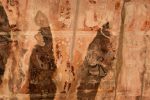
Date: 16th century
Description: The archery contest to win Sita’s hand. Janaka sits on the throne holding Sita on his right thigh while his servants carry Shiva’s bow into the hall.
Location: Andhra Pradesh Temple;Chennakeshava Temple;Somapalem
Positioning: Open mandapa, celiling
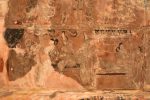
Date: 16th century
Description: From right: Kaikeyi lying in the ‘sulking’room’, with Manthara at the foot of the bed, is visited by Dasharatha. On the left, Rama and Lakshmana take eave of Dasharatha and Kaikeyi.
Location: Andhra Pradesh Temple;Chennakeshava temple;Somapalem
Positioning: Open mandapa, ceiling

Description: Four royal weddings in Mithila.
Location: Andhra Pradesh Temple;Chennakeshava Temple;Somapalem
Positioning: Open mandapa, ceiling
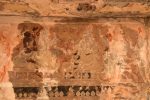
Date: 16th century
Description: King Dasharatha conversing with Vasishtha and another rishi.
Location: Andhra Pradesh Temple;Chennakeshava Temple;Somapalem
Positioning: Open mandapa, ceiling
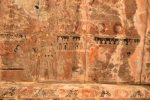
Date: 16th century
Description: On the left: Manthara climbs on the tower and sees the preparations for Rama’s coronation; She reports to Kaikeyi, who retires into the ‘sulking room’. On the right: Scene in a palace: Dasharatha discusses Rama’s coronation with Sumantra (?). Two messengers approach Rama and Sita.
Location: Andhra Pradesh Temple;Chennakeshava Temple;Somapalem
Positioning: Open mandapa, ceiling
« Previous 1 2 3 4 5 6 7 Next »